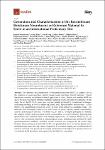Generation and Characterization of Six Recombinant Botulinum Neurotoxins as Reference Material to Serve in an International Proficiency Test
Weisemann, Jasmin
Krez, Nadja
Fiebig, Uwe
Worbs, Sylvia
Skiba, Martin
Endermann, Tanja
Dorner, Martin
Bergström, Tomas
Muñoz, Amalia
Zegers, Ingrid
Müller, Christian
Jenkinson, Stephen P.
Avondet, Marc-Andre
Delbrassinne, Laurence
Denayer, Sarah
Zeleny, Reinhard
Schimmel, Heinz
Åstot, Crister
Dorner, Brigitte
Rummel, Andreas
The detection and identification of botulinum neurotoxins (BoNT) is complex due to the existence of seven serotypes, derived mosaic toxins and more than 40 subtypes. Expert laboratories currently use different technical approaches to detect, identify and quantify BoNT, but due to the lack of (certified) reference materials, analytical results can hardly be compared. In this study, the six BoNT/A1–F1 prototypes were successfully produced by recombinant techniques, facilitating handling, as well as improving purity, yield, reproducibility and biosafety. All six BoNTs were quantitatively nicked into active di-chain toxins linked by a disulfide bridge. The materials were thoroughly characterized with respect to purity, identity, protein concentration, catalytic and biological activities. For BoNT/A1, B1 and E1, serotypes pathogenic to humans, the catalytic activity and the precise protein concentration were determined by Endopep-mass spectrometry and validated amino acid analysis, respectively. In addition, BoNT/A1, B1, E1 and F1 were successfully detected by immunological assays, unambiguously identified by mass spectrometric-based methods, and their specific activities were assigned by the mouse LD50 bioassay. The potencies of all six BoNT/A1–F1 were quantified by the ex vivo mouse phrenic nerve hemidiaphragm assay, allowing a direct comparison. In conclusion, highly pure recombinant BoNT reference materials were produced, thoroughly characterized and employed as spiking material in a worldwide BoNT proficiency test organized by the EQuATox consortium.
No license information

